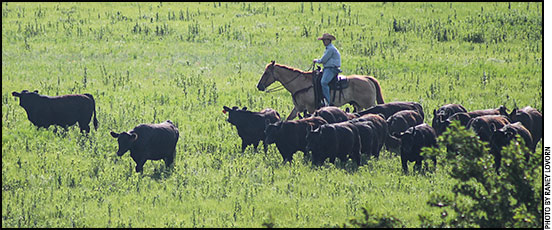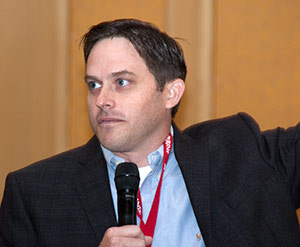
What to Do with Profitability
OSU ag economist urges producers to use current profitability to improve genetics, infrastructure.
High market prices are providing an incentive for producers to grow their herds and increase their profitability, said John Michael Riley, Oklahoma State University (OSU). During the 2015 Beef Improvement Federation (BIF) Annual Convention, Riley addressed factors in the current market that will increase future herd profitability.
Identifying and utilizing a break-even point can help producers evaluate their profitability, said Riley, who recently took a position as assistant professor of ag economics at OSU. Although producers with high variable costs are able to make money with current market prices, historically they would be eliminated. In order to be a low-cost operation and receive the highest incentives on a dollar-value basis, producers should aim well below their break-even point.

“Reducing non-feed costs is paramount,” John Michael Riley said. “Being a jack of all trades can almost get you in trouble. Trying to do many things, gets you doing many things somewhat poorly, instead of doing one thing extremely well.”
“Reducing non-feed costs is paramount,” Riley said. “Being a jack of all trades can almost get you in trouble. Trying to do many things gets you doing many things somewhat poorly, instead of doing one thing extremely well.”
Ranchers are at risk when they do not include their time and effort in their cost analysis, Riley said. For example, raising replacement females could be more expensive for producers in terms of time, labor and feed than they realize. In order to evaluate a true break-even point, ranchers should include all expenses associated with their cattle, not just hard monetary data.
Riley reassured producers there is no magic number for herd size to be profitable. Managing costs is most important to maintaining profitability, regardless of herd size.
“Higher-cost producers are lower-profit producers,” Riley said. “Lower-cost producers are higher-profit producers.”
Riley warned against minimizing costs without thought and consideration. He said making quick decisions could expose producers to unnecessary legal, political, human, price and production risks.
In contrast to cow-calf operations, feedlot profits specifically are influenced by a number of different inputs and outputs, Riley pointed out. Feeder-steer prices, fed-steer prices and feed costs collectively impact 70%-90% of feedlot profits.
Whether in a commercial, stocker or seedstock operation, Riley said all producers are equal in that they cannot change cattle prices. While the market is high, Riley suggested making smart business decisions can contribute to future profitability.
“We need to make more and more of those smart business decisions, because right now the market is paying us, paying you to make those improvements to your farm’s infrastructure,” Riley said.
Costly improvements like new genetics, enhanced herd nutrition and ranch infrastructure like new equipment or extra hired help could greatly impact a ranch’s potential for profitability, he noted.
“Right now the market is putting a little extra cash in your pocket,” Riley said. “Take that cash and do something with it. Improve your infrastructure, improve your genetics as much as possible and that’s going to increase the productivity of your herd.”
The 2015 BIF Annual Convention was hosted by Mississippi State University and the Mississippi Extension Service June 9-12 at the Beau Rivage Casino and Hotel in Biloxi. The Angus Journal and LiveAuctions.tv provide comprehensive online coverage of the event at www.BIFconference.com. Visit the Newsroom page for summaries, proceedings, PowerPoints and audio of the sessions; the Awards page for announcements of award winners; and the Photos page for photo galleries of the tour stops.






